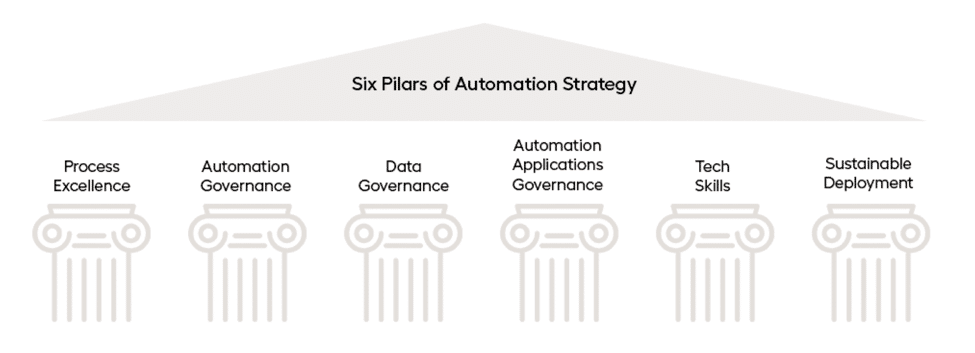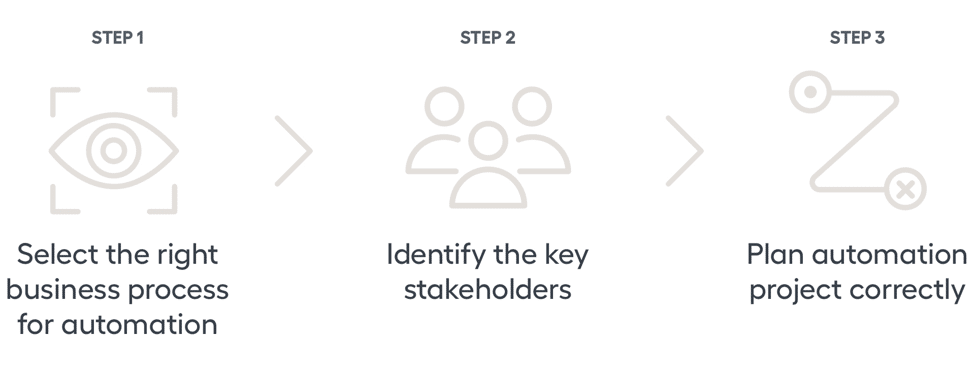Implementing Intelligent Automation in your company can have a lot of benefits, but the success of this endeavor depends on several important factors. It requires the correct combination of people, process and technology, guided by the right automation strategy. The strategy is the core of every automation project, and though there is no “one size fits all” approach to it, there are several critical elements that one needs to address when creating it.
The pillars of the automation strategy

When talking about automation strategy, we usually define the six pillars it should rest upon.
- Process Excellence, which means the business processes are efficient, effective and undergo regular improvement;
- Automation Governance, which prescribes the monitoring, management, and re-architecting of systems under automation;
- Data Governance, which includes management principles, access, and usage decision rights, and securing the data resources;
- Automation Applications Governance, or selection of the right tools for the right job;
- Technical Skills, including hiring, training and technically supporting the professionals necessary for automation success;
- Sustainable Deployment, or maintaining automated applications and documentation to keep applications operating efficiently.
Steps of building an automation strategy
Several important steps will help you build an automation strategy for a successful project.

Let’s review them in more detail.
Step 1. Select the right business process for automation
Failure of as many as a third of all unsuccessful automation projects is attributed to a poor choice of the initial business process for automation. Identifying a strong use case at the very beginning is an important step in your digital journey. It is especially important if you work with robotic process automation without using machine learning capabilities. When selecting the business process, make sure to:
- Consider the format of data and documents involved in the process. For RPA, select processes that use digitized and structured standardized inputs. For Intelligent Automation, you can consider more complex cases that use unstructured data.
- Check whether the process is rule-based or judgment-based. Rule-based processes are perfect for robotic process automation, while with IA it is possible to automate judgment-based processes, too.
- Consider the type of data used. While RPA works best with digital data, Intelligent Automation can be used for processes that handle non-digital data of various types.
Step 2. Identify the key stakeholders
One of the key factors for success in any venture is getting the right people. Automation is no exception. When building the automation strategy, you need to select the right team composition and choose the correct people for it. Make sure that you have competent people to fill in these roles in the team:
- Subject Matter Experts, or SMEs, and Process Owners who know the automated business process inside and out.
- Automation team that includes RPA Developers, ML Engineers and Data Analysts responsible for the project implementation and successful delivery.
- IT & Information Security team to provide guidance on how IA interfaces with the existing technology.
- Infrastructure support staff responsible for running the servers and machines that an automation project requires
It is also important to make sure that stakeholders understand the benefits that automation will bring from the very beginning of the project.
Step 3. Plan the automation project correctly
The next step in building the automation strategy after defining the business process and selecting the team is creating a plan for project implementation. To do it properly, you need to deep dive into the process and collect the requirements. Usually, an Intelligent Automation project will have the following important stages:
- Automation plan to set the project goal, collect high-level requirements and put the priority on their delivery.
- Kickoff meeting to bring the team and stakeholders on the same page and establish their roles on the project.
- Implementation to design and build the automation solution.
- Testing & Production to ensure that automation delivers expected results.
- Roll out of the automated process.
To learn more about creating a plan for an automation project, take our free course in Automation Academy: Automation Essentials. After completing it, you will be able to build a successful automation strategy for your next project.






























